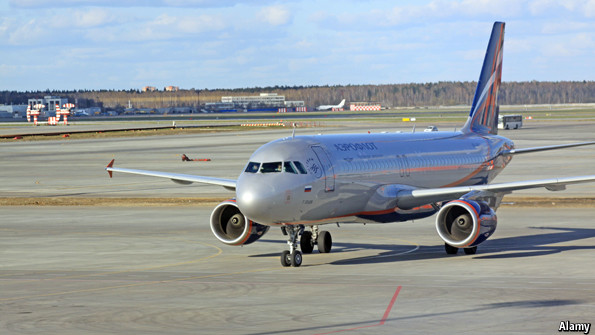
ON FEBRUARY 28th an Atlasjet flight from Istanbul to Crimea made a U-turn over the Black Sea and headed back to Turkey. The pilots had been informed that Simferopol Airport, the main gateway to the peninsula, was occupied by unidentified armed men. Few doubted that the assailants were Russian special forces, whose seizure of strategic buildings would mark the beginning of the annexation of Crimea. It did not take foreign airlines long to see the writing on the wall. Atlasjet, Turkish Airlines, Azerbaijan Airlines and Latvia’s Air Baltic all suspended flights to the peninsula. So too, eventually, did Ukraine’s flag-carrier, Ukraine International Airlines.
Russian carriers are now replacing them, taking advantage of not only the political uncertainty gripping the region, but also a lingering dispute over who controls Crimean airspace. Aeroflot has led the charge. The flag-carrier will double its Moscow-Simferopol service to eight times daily in June. Rossiya, its St Petersburg-based subsidiary, will add a third daily flight. Donavia, another subsidiary based in Rostov-on-Don, where the ousted Ukrainian president, Viktor Yanukovych, took refuge in February, has already added a daily service. Other Russian carriers, such as Nordavia, Grozny Avia and Red Wings, are getting in on the action too. All have felt encouraged by Vladimir Putin. The Russian president has pledged to subsidise airfares between Crimea and its new motherland. And expansion is not only happening in the sky. The Kerch Strait Ferry Line, which links Crimea with Krasnodar Krai, is tripling its passenger capacity to 6,000 people per day.
The status of Crimean airspace remains disputed. According to ICAO, the UN’s aviation agency, Ukraine retains the exclusive right to provide air navigation services over the Simferopol flight information region (FIR). But Russia has seized radio frequencies used by the Ukrainian Area Control Centres in Odessa and Dnepropetrovsk. This gives rise to what Eurocontrol, Europe’s air navigation body, describes as an “unsafe situation” whereby two separate air-traffic service providers can direct planes in the same block of airspace. The perceived risk is so great that Eurocontrol no longer accepts flight plans which cross the Simferopol FIR, instead forcing airlines to circumnavigate Crimea. “Aeroflot wouldn’t fly if it couldn’t guarantee 100% safety to its passengers,” a spokesman told Gulliver. And given the climb-down by Ukraine, Russian flights are indeed travelling through clear skies. But nothing scares off visitors like paranoia about safety, and foreign airlines will not return until the dispute is comprehensively resolved.
Victory, but at what cost?
There is, though, the bigger issue of mainland Ukraine. Whatever gains Russian carriers make in Crimea may be offset by losses elsewhere. Two of the three largest airlines in Ukraine are Russian-owned companies. Before the crisis erupted, Aeroflot Group operated about 500 flights per month from the country. UTair Ukraine, a subsidiary of Russia’s UTair, operated about 800 together with its parent company. Ukraine International Airlines, by comparison, operates just 1,500 across its entire network. Russia's privileged position was enshrined in the countries’ bilateral air agreement. Future arrangements may be less favourable.
The first sign of a clampdown came in March, when Russia’s foreign ministry complained that Aeroflot pilots and cabin crew were being denied entry to Ukraine after landing. This, it said, breached safety regulations by obstructing mandatory rest periods between flights. In April, it emerged that Ukrainian authorities had been blocking Russian males aged 16-60 from entering the country without “confirming documents” that prove their intent. Across the two months, 219 Aeroflot passengers were denied entry to Ukraine. Transaero, another big Russian carrier, had 55 customers turned away in just two days. The restrictions have since been relaxed, though Aeroflot’s flights to Kiev are now held on the tarmac while armed officers with dogs inspect baggage and cargo. At other airports in the south and east of the country, which is more pro-Russian, Aeroflot points to more “friendly attitudes” by ground staff. This may help explain why Ukraine has since banned Russian planes from Donetsk and Kharkiv.
The damage to Russian carriers—imposed or incidental—will become clear when traffic statistics are published. Aeroflot has already reduced frequencies to Kiev and Odessa. Transaero has scaled back its Kiev service, citing “decreasing passenger demand”. UTair Ukraine notes a “significant decrease” in passenger flows across its domestic network. It is focusing instead on foreign charter services, although it denies that international services have been halted.
In fairness, Russian airlines are not alone in feeling the pinch. Wizz Air Ukraine, a subsidiary of the Hungarian low-cost carrier, has suspended the opening of a base in Lviv, temporarily abandoning six new routes. Ukraine International Airlines axed 38 weekly frequencies in February (although it has since added flights to New York, amid much fanfare). Spying opportunity in the turmoil, Atlasjet, the Turkish carrier that ignited the exodus from Crimea, has secured the right to establish a Ukrainian subsidiary.
Russia’s airlines may remain a dominant force in Ukraine, nonetheless. Despite the conflict, ties between the two countries run deep. In Donetsk, the volatile city on the Ukrainian side of the border, almost twice as many flights departed for Moscow last month as for Kiev. The city’s airport is named after Sergey Prokofiev, a Russian composer. Drawing a line between Ukrainian and Russian interests may be no easier in the sky than it has been on the ground.
No comments:
Post a Comment